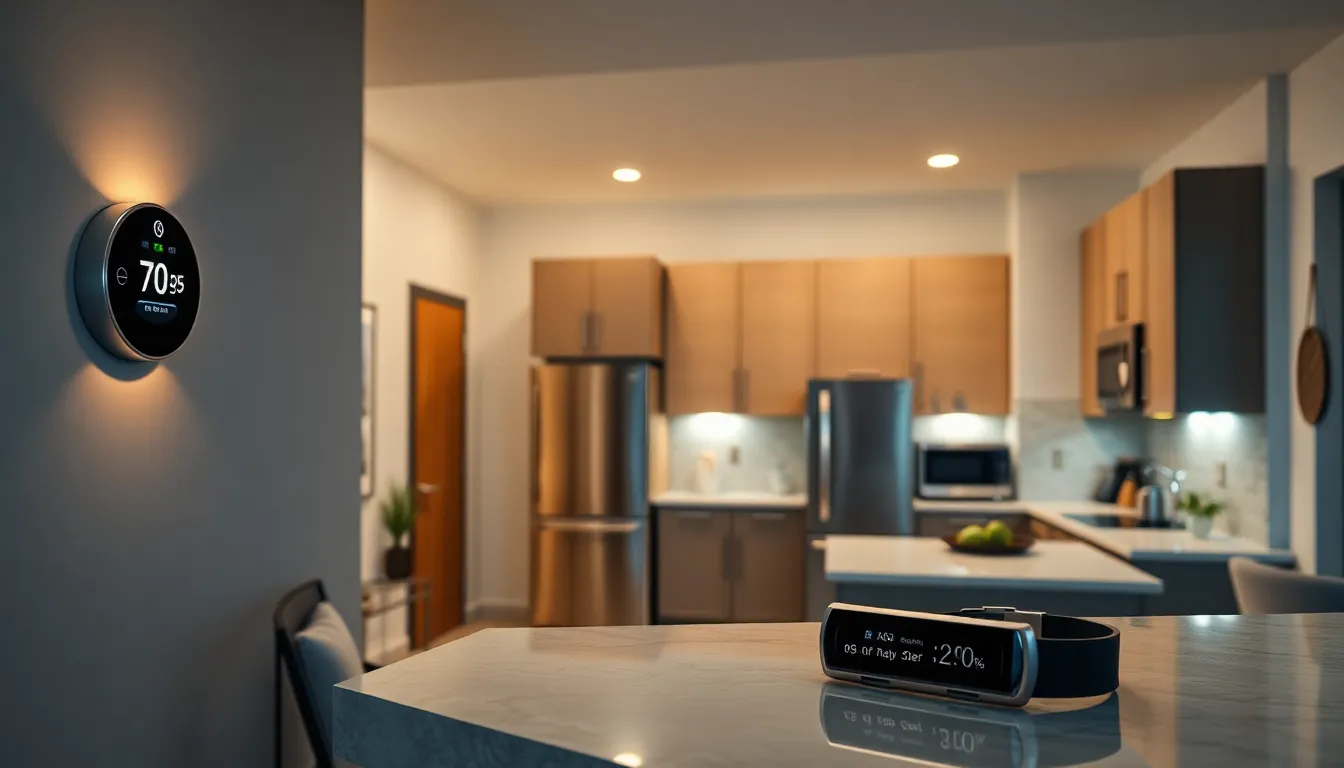Table of Contents
ToggleThe Internet of Things (IoT) is revolutionizing how we interact with the world around us. By connecting everyday devices to the internet, IoT applications are transforming industries and enhancing daily life in ways previously unimaginable. From smart homes that automate mundane tasks to advanced healthcare solutions that monitor patient conditions in real-time, IoT is making a significant impact across various sectors.
As technology continues to evolve, the potential for IoT applications grows exponentially. Businesses are leveraging these innovations to improve efficiency, reduce costs, and enhance customer experiences. In this article, we’ll explore some of the most exciting IoT applications currently shaping the future, highlighting their benefits and the challenges they face. Whether it’s in agriculture, transportation, or urban development, IoT is paving the way for smarter, more connected living.
Overview of IoT Applications
IoT applications span various sectors, transforming traditional methods into efficient processes. This section details significant applications across multiple industries.
Smart Homes
Smart home devices enhance daily living by automating tasks. Examples include:
- Smart thermostats: Adjust temperature based on user preferences, reducing energy bills.
- Smart lights: Enable remote control and scheduling, improving convenience and energy efficiency.
- Smart security systems: Provide real-time monitoring and alerts to enhance home safety.
Healthcare
IoT applications in healthcare improve patient outcomes and operational efficiency. Key examples include:
- Wearable devices: Monitor health metrics such as heart rate and activity levels.
- Remote patient monitoring: Allow healthcare providers to track patients’ conditions in real time.
- Smart medication dispensers: Ensure timely medication intake, reducing the risk of errors.
Agriculture
IoT enhances agriculture through increased productivity and resource management. Relevant examples include:
- Precision farming: Uses sensors to optimize planting, irrigation, and harvesting.
- Livestock monitoring: Tracks animal health and location, improving management.
- Soil moisture sensors: Provide data for efficient irrigation strategies.
Transportation
IoT revolutionizes transportation by improving safety and efficiency. Major applications include:
- Connected vehicles: Share data with infrastructure for real-time traffic updates.
- Fleet management systems: Optimize routes and monitor vehicle performance, reducing costs.
- Smart traffic lights: Adjust based on real-time traffic flow, minimizing congestion.
Urban Development
IoT contributes to smarter urban environments, enhancing quality of life. Examples include:
- Smart waste management: Uses sensors to optimize collection routes and schedules.
- Intelligent lighting systems: Reduce energy consumption based on usage patterns.
- Public transportation monitoring: Provides real-time updates on schedules and vehicle locations.
These applications demonstrate the vast potential of IoT to enhance efficiency, safety, and user experience across various industries.
Industry-Specific Applications

IoT applications significantly enhance efficiency and innovation across various industries. Key sectors experiencing transformation include smart homes, healthcare, and industrial automation.
Smart Homes
Smart homes leverage IoT technology to integrate devices that automate daily tasks. Smart thermostats analyze user behavior to optimize energy consumption, while smart lighting systems adjust brightness based on occupancy. Security systems with IoT capabilities enable remote monitoring and real-time alerts, improving safety for homeowners. Additionally, smart appliances streamline chores by allowing users to control devices from their smartphones, further enhancing convenience and energy management.
Healthcare Solutions
IoT applications revolutionize healthcare by enabling remote monitoring and personalized care. Wearable devices track vital signs, sending data to healthcare providers for real-time analysis. Telehealth solutions connect patients to doctors, providing access to medical advice without in-person visits. Hospitals utilize IoT for asset tracking, ensuring efficient use of equipment and reducing wait times. Medication management systems remind patients to take prescriptions, improving adherence and outcomes.
Industrial Automation
IoT plays a pivotal role in industrial automation through smart manufacturing processes. Sensors collect data on equipment performance, predicting maintenance needs and minimizing downtime. Connected machinery streamlines operations by enhancing communication between devices, boosting production efficiency. Supply chain management benefits from IoT with real-time tracking of inventory levels, allowing businesses to optimize stock and reduce waste. Predictive analytics derived from IoT data drives informed decision-making across production workflows.
Benefits of IoT Applications
IoT applications deliver numerous benefits across various sectors, enhancing both efficiency and effectiveness in everyday operations. Key advantages include improved operational insights and data-driven decision-making.
Enhanced Efficiency
Enhanced efficiency emerges as a primary benefit of IoT applications. Smart systems streamline operations by automating tasks and optimizing resource usage. In manufacturing, for example, connected machinery facilitates continuous monitoring of equipment performance, predicting maintenance and minimizing downtime. In logistics, IoT-enabled tracking systems ensure warehouses operate efficiently by optimizing inventory levels and routing. Smart buildings utilize IoT sensors to manage energy consumption, cutting costs and reducing waste. Overall, organizations leveraging IoT improve productivity and reduce operational costs.
Real-Time Data Monitoring
Real-time data monitoring stands out as a critical advantage of IoT applications. Connected devices collect and transmit data instantaneously, providing insights into system performance and user behavior. For instance, in healthcare, wearable devices track vital signs and transmit data to medical professionals in real time, enabling timely interventions. In agriculture, IoT sensors monitor soil moisture and crop health, allowing farmers to make informed decisions regarding irrigation and fertilization. This continuous influx of data not only enhances situational awareness but also drives proactive rather than reactive management strategies, contributing to enhanced outcomes in various industries.
Challenges in Implementing IoT Applications
Implementing IoT applications poses several challenges that organizations must navigate to fully harness their potential benefits.
Security Concerns
Security concerns remain a primary challenge in IoT application implementation. Devices often lack robust security features, making them vulnerable to cyberattacks. A study by Symantec revealed that 70% of IoT devices can be easily compromised. Insecure devices grant malicious actors access to sensitive data, leading to potential privacy breaches. Organizations must implement encryption, authentication, and regular software updates to mitigate these risks effectively.
Interoperability Issues
Interoperability issues complicate the integration of diverse IoT devices and platforms. Various manufacturers employ different communication protocols, hindering seamless interaction between devices. According to IBM, 60% of IoT projects fail due to compatibility issues. To address this challenge, standardization of communication protocols is essential, fostering collaboration between manufacturers and promoting the development of universal solutions.
Future Trends in IoT Applications
IoT applications are poised for significant advancements as technology evolves and industries adopt innovative solutions. Emerging trends outline the future of IoT across various sectors.
- Enhanced Artificial Intelligence Integration
Enhanced artificial intelligence integration streamlines decision-making in IoT devices. AI algorithms process data from connected devices, enabling predictive analytics that improve operational efficiency. Businesses utilizing AI can forecast equipment failures and optimize maintenance schedules.
- 5G Connectivity
5G connectivity revolutionizes IoT performance by providing faster data transfer rates and lower latency. This enhanced network capacity supports real-time data processing, making connected devices more responsive. Industries like healthcare and transportation will benefit from improved communication and seamless interaction among IoT devices.
Edge computing shifts data processing closer to the source. This reduces the reliance on centralized cloud systems, enhancing speed and reliability. With edge computing, devices can analyze data locally, freeing up bandwidth and enabling faster decision-making in critical applications, such as autonomous vehicles.
- Advanced Security Solutions
Advanced security solutions become imperative as IoT expands. Innovations like blockchain technology create tamper-proof data records, enhancing device security. Manufacturers are likely to focus on developing built-in security features to protect users from cyber threats.
- Sustainability Initiatives
Sustainability initiatives drive IoT applications toward eco-friendly solutions. Smart energy management systems optimize resource use, while IoT-enabled environmental monitoring enhances conservation efforts. These applications promote resource efficiency in sectors such as agriculture and urban development.
- Mixed Reality in IoT Applications
Mixed reality technologies, combining virtual and augmented realities, will enhance user interactions with IoT systems. These immersive experiences provide users with intuitive interfaces for device management, enabling better decision-making and control.
Future trends in IoT applications signal a transformative impact on industries and everyday life. The evolution of technology paves the way for innovative solutions that improve efficiency, security, and user experience across various sectors.
The Internet of Things is reshaping industries and daily life in remarkable ways. With its ability to connect devices and streamline operations, IoT applications are driving efficiency and enhancing user experiences across various sectors. As technology advances, the potential for innovation grows, paving the way for smarter solutions that address modern challenges.
However, the journey isn’t without obstacles. Security concerns and interoperability issues must be tackled to unlock the full potential of IoT. By prioritizing robust security measures and standardizing communication protocols, businesses can create a more secure and interconnected environment.
Looking ahead, the integration of AI, 5G, and edge computing will further revolutionize IoT applications. As these trends evolve, they promise to enhance efficiency, safety, and sustainability, making IoT an essential component of future advancements. The future of IoT holds exciting possibilities that will undoubtedly transform how we live and work.





